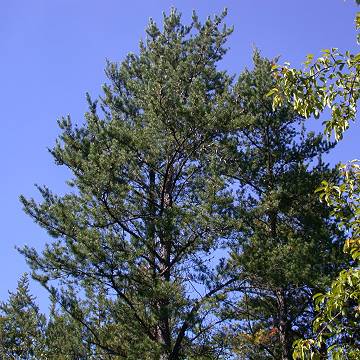

Pinus banksiana - (image 1 of 6)
Taxonomy
Family: Pinacea
Habitat
Sandy soils, such as dunes, pine barrens. Most often areas with a history of fire. Very cold tolerant (USDA Zone 2 to 6).
Associates
Celatrus scandens, Cornus stolonifera, Quercus velutina, Prunus virginiana, Ptelea trifoliata mollis, Rhus aromatica arenaria, Smilacina stellata, Toxicodendron rydbergii.
Distribution
Grows near the Artic Circle, south to northern NY and MN. At least one stand occurs in northeast IL, although it may have been planted.
Morphology
Upright, evergreen conifer to 70', usually smaller. Crown spreading, often irregular. Leaves in pairs, persisting 2-4 years, green, becoming yellowish in winter, stiff, slightly twisted, to 2" long, margin with minute teeth, apex acute. Buds dark brown, to 1/4" long, cylindrical with closely pressed scales. Bark red-brown to gray, furrowed into thick plates in older trees. Cones to 2.5" long, gray-brown, ovoid-conical, curved and pointed, most often closed.
Notes
Flowers early May to early June
Wetland indicator: Facultative Upland
The cones normally do not open unless subjected to considerable heat, such as is experienced in a fire. The endangered Kirtland's Warbler (Dendroica kirtlandii) nests exclusively in dense, scrubby jack pine stands. These stand must experience periodic fires in order to maintain a mix of jack pines of suitable age for nesting. While this tree is known for growing in sandy, acid soils, it can apparently tolerate dry, clayey, somewhat more alkaline soils.
Bibliography
Dirr, Michael A. 1998. Manual of Woody Landscape Plants:
Their Identification, Ornamental Characteristics, Culture, Propagation and Uses.
5th ed. Champaign, Illinois: Stipes Publishing L.L.C.
Swink, F. and G. Wilhelm. 1994. Plants of the Chicago Region.
Indiana Academy of Science. The Morton Arboretum. Lisle, Illinois.
|
Michael Hough © 2005 |